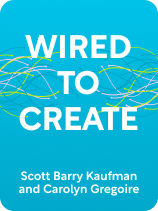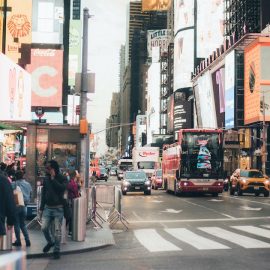

This article is an excerpt from the Shortform book guide to "Wired to Create" by Scott Barry Kaufman and Carolyn Gregoire. Shortform has the world's best summaries and analyses of books you should be reading.
Like this article? Sign up for a free trial here.
What are the most common characteristics of creative people? Is there truth to the lonely artist trope? Why should creatives try new experiences?
In their book Wired to Create, Scott Barry Kaufman and Carolyn Gregoire say that creatives possess 10 characteristics that encompass these traits and result in their heightened creativity. By embracing these characteristics, you too can maximize your creative potential.
Continue reading to learn about each characteristic.
1. Childlike Imagination
The first of the ten characteristics of creative people is having a childlike imagination. This characteristic is defined by the desire to create something fun or enjoyable out of something typically mundane. In childhood, this characteristic is present whenever we play pretend—we pretend that a fallen tree in the forest is a kitchen counter and that pinecones and leaves are ingredients for a stew. Or, we make up a fantasy world and act out character roles with our friends.
In adulthood, this characteristic manifests when we explore our thoughts and experiences and use them to create something. The act of creation is “play” for the adult creative. For example, theorizing about something and sharing your theory is creative play—you use your childlike imagination to take something mundane and create something new. Channeling your experiences into a book, play, painting, and so on is also a form of creative play—you’re transforming your real life encounters into something new that you can share with others.
2. Daydreaming
The second characteristic that Kaufman and Gregoire say creative people share is the habit of daydreaming. Daydreaming is when you explore your thoughts and let your mind wander as opposed to consciously directing your attention to one particular thing. Daydreaming may take the form of fantasizing about certain scenarios, exploring memories, imagining the future, contemplating certain experiences or emotions, and so on.
The authors explain that daydreaming is critical for creativity because it gives our task-focused mind (the one used in flow) a break and allows us to process the experiences and information we’ve gathered. The enhanced understanding about our lives and ourselves that we gain during this processing state allows us to come up with unique ideas and insights that we share through creative expression.
3. Passion
The third characteristic that Kaufman and Gregoire say creatives share is passion. Passion is defined by a lasting, intense inner drive to achieve a particular thing. For creatives, passion is often a primary source of meaning in life and one of the driving factors behind their will to live.
According to the authors, there are two phases of passion. First is the crystallizing experience—this is when the creative first encounters their area of passion and has the revelation that this is something they’re compelled to pursue. Second is the refining experience where the creative uncovers their specific niche within their area of passion.
4. Solitude
The fourth characteristic that the authors say artists share is the desire for solitude. The lonely artist trope has existed for centuries, and the authors explain that there’s a good reason for this: Creativity stems from an intimate understanding of one’s self and humanity, and these discoveries are the product of deep reflection, which requires solitude.
In solitude, people are granted the time and peace needed to fully explore their thoughts, emotions, and experiences, and to contemplate things they wouldn’t normally think about. This deep contemplation is the catalyst for meaningful epiphanies about yourself and the world—the tissue of creative work. Distractions in the outside world often prevent this intense inner focus, which is why solitude is crucial for creativity.
5. Mindfulness
The fifth characteristic the authors say creatives share is mindfulness. The authors define mindfulness as the ability to pay attention to the finer details of life in both your outer and inner world—for example, noticing the bumps and ridges on a tree’s bark or the way you feel when you watch a certain part of a movie.
The authors explain that the combination of daydreaming and mindfulness seems contradictory but is the perfect formula for creativity. Daydreaming allows your mind to think about and notice many different things, and mindfulness allows you to hone your focus and elicit meaning from things you find particularly impactful. The combination of these two characteristics is the formula for finding meaning in life and developing insights into the human experience—the two main drives that encourage creative people to create.
6. Experiential Curiosity
The sixth characteristic that the authors say creatives share is experiential curiosity—the desire to learn about yourself and the world through new experiences. Experiential curiosity is one of the biggest driving factors of creativity because new experiences are often the foundations of creative work—creativity arises when we break our typical patterns. Further, people who seek new experiences and knowledge tend to be more driven to find and make meaning out of the world around them, and this meaning is the material of creative expression.
7. Intuition
According to the authors, the seventh characteristic creatives share is strong intuition. Intuition is an inner feeling you have that urges you to do something or change your frame of mind. For example, intuition can be an intense emotion, the urge to explore something, a sense of knowing something you can’t prove, and so on. The authors explain that intuition, or gut instinct, is often a catalyst for creative insights. Many creative people believe that their intuition, and consequently their creative insights, come from some higher power.
8. Sensitivity
The eighth characteristic that the authors say creatives share is sensitivity. Sensitive people experience intense emotions and often are more in tune with and impacted by their surroundings. They’re also more likely to be strongly emotionally impacted by their experiences—both positively and negatively.
The authors explain that sensitivity is linked to creativity for a few reasons. First, sensitive people have more intense emotional experiences, and emotions are often the inspiration for creative expression. Further, sensitive people tend to pick up on things that most people don’t. This provides them with a deeper understanding of the world, which sparks creative insights.
9. Creative Resilience
The ninth characteristic that the authors say creative people share is creative resilience—feeling their emotions intensely, using them to develop a deeper understanding of themselves and the world, and then sharing the insights they’ve gained through creative expression.
The authors explain that many artists use creative expression as a way of releasing pain and suffering. Turning pain into art, for example, helps creatives cope because it makes their suffering meaningful. Sharing their experiences is also cathartic because it allows creatives to connect with others—it makes them feel less alone in their experiences and produces the same effect for those viewing their art.
10. Unconventional Thinking
The final characteristic that the authors say creative people share is unconventional thinking. Creatives tend to think beyond standard rules and expectations that traditionally limit people. They break barriers and set new trends by refusing to conform.
The disruption that creative people cause often paves the way for massive change—for example, an inventor often needs to challenge what we know about science to create new commodities that make our lives easier or more efficient. However, the authors note that because creative work breaks norms and traditions, it often goes unrecognized initially. This is because people typically praise conformity and resist things that are different.

———End of Preview———
Like what you just read? Read the rest of the world's best book summary and analysis of Scott Barry Kaufman and Carolyn Gregoire's "Wired to Create" at Shortform.
Here's what you'll find in our full Wired to Create summary:
- What creativity truly means—and why it’s hard to define
- The 10 characteristics of creative people
- How to maximize your creative potential






